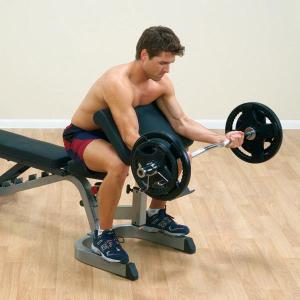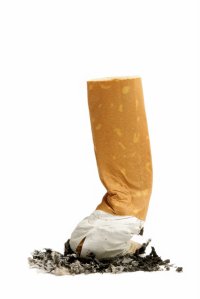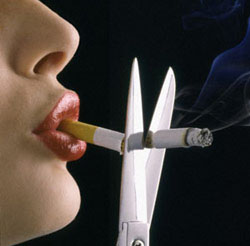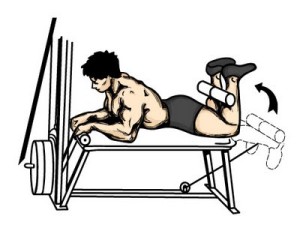Upper arm development is probably one of the most sought-after bodybuilding goals. I have yet to meet an elite pro bodybuilder pleased with his upper arm development, even though that arm development exceeds the 20-inch circumference.
If you’ve been frustrated recently with your lack of progress in upper arm development, follow any one of the seven tips given here and you are surely going to experience new growth in record time.
1. Don’t train biceps with back and triceps with chest
Training biceps after doing your back routine and training your triceps after a chest workout are antiquated training concepts. For example, when one does a full back workout, there’s plenty of residual fatigue in the elbow flexors from all the chins, rows and pulldown exercises that drastically reduce the training poundages in all curling exercises, thus falling short of optimal loading for the elbow flexors. At this point, you are using loads that fall short of the optimal training zone for overloading properly the contractile proteins. I strongly suggest that in order to improve the strength and size of your upper arms, they should be trained alone as a training unit. That leads us to point number two.
2. Train using the double station system
For every elbow flexion exercise, you should alternate an elbow extension exercise. Even though you may be thinking I’m just talking about supersetting biceps and triceps, I beg to differ on a subtlety. With a superset, little or no rest is taken between the agonist and the antagonist muscles. In the approach I strongly endorse, I prefer to use longer breaks between the two stations for the following reasons.
By having the antagonistic pairs contracting alternately (e.g. flexion followed by extension) as opposed to agonist contractions alone (precontraction of antagonists), the ability of achieving full motor unit activation (MUA) in a muscle contraction may be enhanced when immediately preceded by a contraction of the antagonists. This has the added benefit of allowing you to double the workload per training unit. It is important to alternate exercises working agonists muscles with exercises working antagonistic muscles together, while respecting long rest intervals. For example, after doing a 3RM set of close grip triceps presses, rest two to three minutes, perform a heavy set for the antagonist muscle (i.e., 3-4RM set of dumbbell curls for the biceps), rest another two to three minutes and repeat the procedure for the required number of sets.
With double station training, you get the added benefit of making sure both sides of the joints are equally loaded with optimal training loads, while in classic supersets, endurance levels may at times make the trainee compromise on utilizing the right amount of weight to overload the contractile proteins.
3. To gain arm strength, pause between reps
Too often, trainees fail to make mass gains in their upper arms because their strength in biceps and triceps exercises has been stagnating for awhile. But, there is another way out. Research by Canadian exercise physiologists has shown that for a given submaximal force of contraction, motor unit activation is greater for repeated (intermittent) than for sustained contractions. Pausing between reps helps offset the oxygen debt associated with sustained contractions by various mechanisms, one of which is allowing the removal of waste products from the muscle cell that block the optimal neural drive. This type of intra-set rest allows for the recruitment of higher threshold motor units, which is essential for strength gains. Make sure these pauses are no more than 15 seconds in length and are taken where muscles can rest, such as when your arms are outstretched.
4. Don’t neglect the forearms
When a bodybuilder complains of stagnation in mass and strength gains in the elbow flexors, I often recommend adding some direct grip and forearm work. When you include direct forearm and grip work, your curling poundages go up because a few forearm muscles, such as flexor carpi radialis, contribute to elbow flexion; this leads to furthering biceps and brachialis development. As you know by now, heavier weights mean greater overload on the muscular structure, and greater overload on the muscular structure means greater hypertrophy.
Elite bodybuilders of the sixties, Chuck Sipes and Larry Scott, were known for handling Herculean weights in curling exercises. They were very strong proponents of complementary forearm training for upper arm development. The other added benefit is that the aesthetics of your upper arms will also be enhanced.
Frequently, doing three sets each of wrist flexors work, wrist extensor work and grip work, jolts one’s progress to new levels. A sample tri-set could look like this:
- A-1 EZ-bar handle low palms up – Wrist Curls 3 x 15-20 reps on a 2010 tempo; rest 45 seconds.
- A-2 EZ-bar handle low palms down – Wrist Curls 3 x 15-20 reps on a 2010 tempo; rest 45 seconds.
- A-3 Gripping Machine 3 x 10-12 reps on a 2013 tempo; rest 45 seconds.
As you can see from the tempo, you’d isometrically hold the contraction for three seconds when the hands are closed. For the two types of low pulley wrist curls, the Tribar company makes a very interesting handle with rotating sleeve. The shape of the grip makes for a more ergonomic and comfortable position. Recently, Dorian Yates visited my training site for soft tissue work and he was quite intrigued with the Tribar handles.
When doing grip work, stay away from choppy reps. When you are lowering the grip handles, make sure on every rep that the handles are at the very tip of your fingers so it will feel like you’re just about to lose your grip.
This will insure a greater range of motion, thus greater development. Once the handles are brought back together, squeeze with all your might. Keep in mind that one of the fastest ways to improve your forearm size and gripping strength instantly is to forego the use of lifting straps when training the upper body.
5. Train your traps
If the arm’s muscle mass is not balanced with the trapezius and deltoid development, the sheer weight of the arms will block its neural drive because the proper alignment of the upper extremities will be faulty. Adding some direct trap work on upper back training day should do the trick. Best choices for exercises would include one arm shrug with dumbbell or low pulley, which permits greater range of motion than raising both scapulae at the same time. Another great exercise for trap development is the power snatch from mid-thigh.
6. Give the 6-12-25 method a try
It consists of doing a heavy set of six reps. Take a 10-second break, switch the exercise and do 10-12 reps. Take a 10-second break, switch to a new exercise and perform an agonizing 25 reps with it. After this, a much needed two-minute break is required before the cycle is repeated once, and at most, twice. One should expect to have to decrease the load between 10 to 20 percent for the second cycle to meet the desired repetitions brackets.
For the six rep sets, I prefer exercises in which the muscles are in a pre-stretched position, as in incline curls for the biceps and overhead low pulley extensions for the triceps. For the 10-12 rep sets, I prefer to use exercises that overload the mid-range of the strength curve, such as barbell curls for the biceps and dips for the triceps. For the 25 rep sets, machines or pulley devices that offer a more uniform tension on the muscles throughout the range of motion work very well. It will take some experimenting at first to determine the right load, but once you have dialed into it, it’s extremely effective for building large muscular arms.
7. Specific brachialis training
The brachialis muscle is a widely neglected muscle in the bodybuilding world. However, every single bodybuilder who has phenomenal arm development sports a pair of fully developed brachialis muscles. When you see Ronnie Coleman do his back double biceps pose, his brachialis muscles are the tennis ball-shaped muscles you see between his triceps and biceps muscles. The brachialis muscle is better known among kinesiologists as the workhorse of elbow flexion. That is, it works in all elbow flexion movements, whether the forearm is pronated, supinated, or in between. When the forearm is supinated (palms-up grip), the biceps have an effective line of pull. However, when the forearm is pronated (palms-down grip), the biceps is rather ineffective in flexing the elbow. When your forearm is pronated, the brachialis takes the toll and pulls the resistance almost alone.
In order to objectively measure your brachialis muscle, you need specific work. Go on the Scott bench and curl five or six reps with maximum weight on the barbell curls with a supinated grip. After a 10-minute rest, you should be able to reverse curl with an EZ bar 76 percent of that weight for five or six reps. If you cannot do so, your brachialis muscle will need specific muscle work. If you don’t already do one of the various forms of reverse curls as part of your workout, adding it could surely result in 1/2 to one full inch of arm growth in a month’s time!
Make sure to always perform at least one specific brachialis exercise when training your upper arms. Your arsenal of brachialis exercises in the arms race include: reverse Scott curls (wide or narrow grip, low pulley or EZ bar), hammer curls, Gaspari bar curls, Zottmann curls (seated or one arm at a time on the Scott bench).
Sanjeev Nanda TIP
If you have neglected your brachialis muscles, here’s a very good program to pack size on them. This program involves what is called a post-exhaustion system. That is where you do a compound (multiple joint) exercise that recruits a lot of motor units, and follow it immediately with a superior isolation exercise that also taps well into the motor unit pool. Just by the amount of delayed onset muscle soreness you will get from this routine on your first go at it, you will be convinced of its efficacy at building large muscular arms. The routine looks like this:
Post-Exhaustion Cycle
- A-1 Narrow Grip Pronated Pull-Ups 4 x 4-6 reps @ 4010 tempo
- A-2 Pause Standing Reverse Curls 4 x 6-8 reps @ 3210 tempo
- Rest 10 seconds between A-1 and A-2
- Rest three minutes between A-2 and A-1
- Rest 10 seconds between B-1 and B-2
- Rest three minutes between B-2 and B-1


























